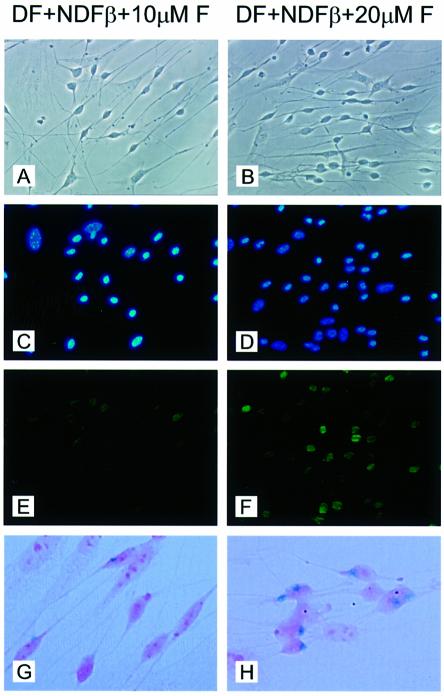Fig. 4. Induction of β-galactosidase expression in SCE–LacZ transgenic Schwann cells parallels induction of Oct-6 protein expression in response to forskolin. Primary Schwann cell cultures were established from wild-type and SCE–LacZ transgenic animals at postnatal day 4. Cells were cultured in defined medium (DF) supplemented with 5% NDF-β conditioned medium and exposed to 10 µM forskolin (A, C, E and G) or 20 µM forskolin (B, D, F and H) for 48 h (see Materials and methods). (A and B) Phase contrast photographs of primary Schwann cell cultures derived from wild-type animals. (C and D) 4′,6-Diamidino-2-phenylindole (DAPI) staining of nuclei of the cells shown in (A) and (B), respectively. (E and F) Many Schwann cells express Oct-6 (green) when exposed to 20 µM forskolin (F), while only few Schwann cells express Oct-6 when exposed to 10 µM forskolin (E). Fibroblasts, which are easily recognized by their flattened morphology and large nucleus, never express Oct-6. (G and H) Bright-field images of X-gal-stained SCE–LacZ primary Schwann cells. In cultures exposed to 20 µM forskolin (H), many cells with a Schwann cell morphology show a blue precipitate, while only few such cells are observed in the culture exposed to 10 µM forskolin. Fibroblasts, which are recognized by their flattened morphology and their pronounced nucleoli, do not express the transgene. Cells were counterstained with eosin.

An official website of the United States government
Here's how you know
Official websites use .gov
A
.gov website belongs to an official
government organization in the United States.
Secure .gov websites use HTTPS
A lock (
) or https:// means you've safely
connected to the .gov website. Share sensitive
information only on official, secure websites.
